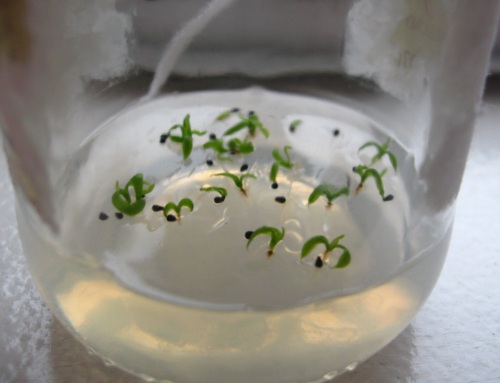Tissue Culture Experiment 1
Man, having a job really infringes on my plans for world domination, no matter how much I intentionally suck at my job. This update is long overdue.
This all began a few months ago, when I decided to learn to do tissue culture so that I could ultimately clone myself. I started with plants, since plant tissue is easy to work with, and I have had a lot of practice with, uh, herb gardening. My first attempt at tissue culture succeeded only in growing plates of mold. I threw those out, although I suppose I could have harvested some penicillin.
For my next attempt, I put some venus flytrap seeds in plain agar with no additives. I was still quite lax with my sterilization techniques, but none of the plates were contaminated this time because there was nothing but agar.

I moved one plate of seeds to peat moss shortly after germination because the agar was drying out. The other plate remained for about a month after germination. I finally moved the last plate to soil because the specimens were looking sickly.

There were a number of things that I did wrong with my tissue culture.
Sugar: I had originally thought that adding sugar to the agar would be stupid because, wtf, plants don’t eat sugar. But one reason why the ex-vitro plants did so much better than the in-vitro ones was the availability of light. Plated samples cannot be kept under direct sunlight or they’ll cook. Thus, plant tissue cultures do not rely on photosynthesis as an energy source. Sugar must be added to the growing media — apparently, plants can absorb and transport sucrose. (This doesn’t work well with ex-vitro plants because the bacteria and ants will get to it first.)
Venting: I used those swine-flu-epidemic surgical masks as lids for my cultures. Keeps the germs out, but still allows airflow. Not necessary, and allowed the agar to evaporate quickly. If photosynthesis is not transpiring, then there will be minimal need for gas exchange. Cleaner to use a closed lid.
Replating: The seedlings should have been replated after the first traps started forming. The nutritional requirements of a growing plant are different from those of a seedling which is still deriving nutrients from the seed.
Other additives: Thiamine is essential to carbohydrate metabolism, macronutrients such as N, P, K as fertilizers, plant growth regulators like cytokinins, and other stuff but I stopped reading because I got bored [1].
I’m going to try one more time.
1. Trigiano, R. and Gray, D. Plant Tissue Culture Concepts. CRC Press, 1999.